The Council on Postsecondary Education’s 2021 Stronger By Degrees Progress Report http://cpe.ky.gov/data/reports/2021progressreport.pdf shows growth worth celebrating in overall educational attainment, KCTCS graduation rates, and STEM+H degrees, along with slower progress on bachelor graduation rates and a concerning decline in higher education enrollment. This year, that good news is especially impressive: results reported now include successes posted as a pandemic swept over the state, disrupting learning opportunities and demanding unprecedented teaching innovations.
Rising Attainment
49.4% of Kentucky adults ages 25-64 held a postsecondary degree or certificate in 2019, moving up steadily from 43.6% in 2015. If we sustain that rate of improvement over the coming years, Kentucky will reach our ambitious 2030 goal of 60% attainment.
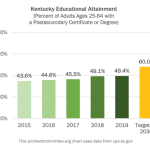
Rising Credentials
The number of postsecondary credentials being earned(bachelor degrees, associate degrees, certificates and diplomas) has continued to rise. At KCTCS, 2020 results meet 2021 targets ahead of schedule, a fact marked with a star in the chart below. Public universities have also increased the number of bachelor degrees being awarded, though with slower growth and at a pace that could signal difficulty meeting the target set for next year.
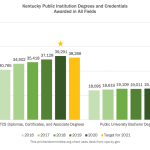
Rising KCTCS Graduation Rates
A 36.3% graduation rate for 2020 means the Kentucky Community and Technical College System has met its 2021 target of a 34.0% three-year graduation rate. For underrepresented minority students and for low-income students, KCTCS graduation rates have been rising faster than overall, meeting the 2021 targets in 2019 as well as 2020.
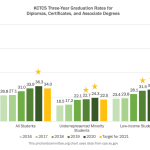
Rising STEM+H Degrees
Science, technology, engineering, mathematics, and health (often called STEM+H) credentials are a special priority because of their powerful role in the economy. Kentucky institutions have met their 2021 goals ahead of schedule, with 13,787 credentials awarded by KCTCS and another 6,636 awarded by the universities.
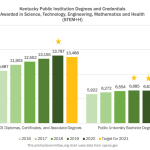
Slowly Rising Bachelor Degrees
Kentucky’s public universities have increased their bachelor program graduation rates, but not at the pace needed to meet Kentucky’s 2021 targets for all students, low-income students, or underrepresented minority students. To be clear, the increases shown below are moves in the right direction. We need to keep moving, and move faster, in that direction.

Declining College-Going Rates
The big point for concern in this data is enrollment. From the 2019 class of Kentucky high school graduates, only 50.5% enrolled at Kentucky postsecondary institutions in 2020 to continue their education in the 2020-21 school year. That’s down from 54.0% for the class of 2015. From other reporting https://prichard-backup.com/July/kentuckys-fafsa-completion-rate-is-lagging-prior-year/, we also know that the decline in college going has been especially severe for high school graduates with low family incomes . And this problem is matched by difficulty in in enrolling adults between 25-64 who have not yet earned degrees, with only 2.6% of those Kentuckians enrolling in the fall of 2019. Kentucky is losing important opportunities here, both for the individuals involved and for our statewide goals for workforce and citizenship development.
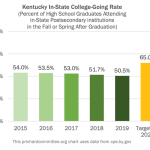

Concluding Thoughts
Respect is due. The progress noted above is important growth, delivered against the challenges of a rising pandemic and its associated recession.
Concern is warranted. After these strong results were delivered, we know the school year now underway has required continued innovation and have conducted in the context of continued disruption to family, work, and classroom living. Spare a gentle thought for everyone involved in making that work, as they put in mighty effort to try to deliver another year of growth like the results above.
Investment will be needed. It is important good news that the General Assembly increased higher education funding https://prichard-backup.com/July/14489-2/ for this year and that the federal American Rescue Plan https://www.governing.com/now/New-Billions-for-Higher-Ed-Come-with-Spending-Flexibility.html will also provide added resources for higher education. Be on the lookout for evidence on whether the additions meet current needs and whether future budgets follow through on addressing the challenges. Perhaps especially, look for information about work to move more Kentuckians into higher education and about the supports that work may need.
A big, bold future is in reach. This year’s report shows Kentucky progress in building that future, even as it alerts us to the challenges we must master next.





Comments are closed.